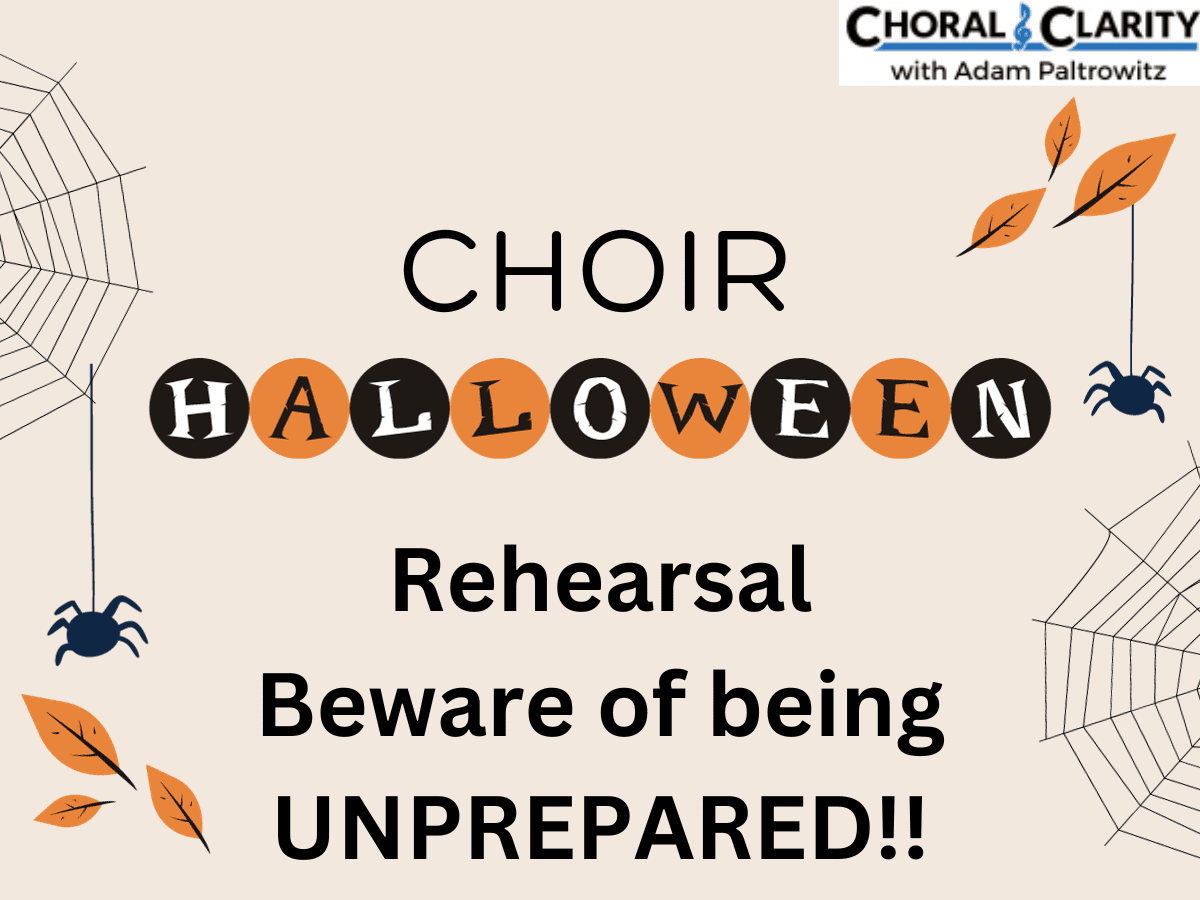Retention is more important than recruitment. Recruitment is a means to get students in the door but retention is how we keep the students that we currently have from leaving.
In the business world, companies are constantly looking to gain new customers by offering creative deals to get them in the door; it is their hope that these first-time customers will become frequent and repeat customers.
In our choral programs, we can’t afford to “hope” that the random students who walk through the door will take our “free pizza party” and turn that into a multi-year commitment. Bringing in a large new class every year provides far less success than maintaining a relatively small, yet focused class where everyone continues.
Don’t Recruit Until You’ve Done This First
In my opinion, the primary goal of any successful program should be retaining our current students year after year. Once we have built a stable program, an overall 85% or greater retention rate should be a viable goal with a minimum 75%-80% retention rate for 1st year students.
Our retention of students is not successful long-term by using bells and whistles; it relies mainly on presenting the nuts and bolts of our program and offering clear reasons why each and every student should continue.
We hear so many excuses for why students drop our class, especially after their first year. Here are some common excuses:
– they have already met their requirement for music/art and do not need to take another music class
– they want to take more rigorous academic classes
– they experienced pressure from their guidance counselor to try something else because they already took “choir”
– they experienced pressure from parents and/or guidance counselor to take classes that look better on their college resume
– they experienced pressure from parents and/or guidance counselor to take classes that are more career-oriented
The excuses listed above, while valid and logical, each demonstrate a one-sided perspective that in many cases can be shifted. If we are highly effective educators who also take the time to educate our students about WHY they should choose to continue in our program, we are likely to see a noticeable increase in our annual retention rate.
In order to keep our students from dropping, we must first ensure that what we are offering them can be more compelling than the potential excuse they have for choosing not to continue.
Here are 12 Tips to Keep Them from Dropping Choir!
1. Get to know all students
Every student is an individual. If we look to find a way to connect with each student, they will be more likely to connect with us. Many students choose a teacher rather than a class. Our one-on-one contact with every student shows our personal investment in them. This connection is more about who they are outside of choir than what they give to our choir.
Try SIGHT READING FACTORY and save 10% using code: choralclarity
– the best classroom sight-singing tool on the market!!
2. Provide the opportunity for upward mobility
Students need to see a long-term path for personal growth and leadership. If students view the following year as a repeat experience, many will choose not to continue. If they see upward mobility as something that is only offered to the top singers, we will lose most average and below-average singers.
* The first-year retention percentage is reflective of 75-80% of all enrolled students continuing, regardless of talent, skill, or dedication level.
How To Develop All Students into Great Sight-Singers
3. Offer Increased Musical Opportunity with each successive year
Students need to see that each year breeds more opportunities for personal musical growth and achievement. If each grade of students has more performing opportunities, students will have something to strive for. Some examples of increased opportunities could be having a senior recital, or taking advantage of a state organization’s solo festivals where Juniors and Seniors have the opportunity to be selected for All-State or All-National choir.
4. Instill a sense of family
When the choir connects like a family and treats every member like they matter, many will look forward to continuing. Choir families have social parties, bowling nights, movie nights, holiday gift exchanges, etc. When every student feels included in these events, they become vested in the core of our program. For some students, making music is less important than having a sense of belonging. Feeling part of something is what keeps them engaged for the long haul.
5. Cultivate Tradition
Students need to feel like there is something that continues far beyond one or two years. When alumni return year after year and certain songs and activities are ingrained in the culture, our current students feel like they are part of something special; many of our students will begin to envision themselves as alumni returning year after year, maybe even with their younger sibling in our choir.
The Best Aural Training Exercise
6. Strive for Individual achievement
Students who recognize clear individual growth will likely be more vested in continuing. If students voluntarily commit to perform at a solo “ratings” festival, for example, they will work hard to prepare. This preparation in itself may lead to significant tangible growth, which will keep them connected. Students who see self-improvement in sight-reading, ear-training, or successfully performing solo repertoire, will become more motivated for the next level of growth to come through continuation in our program.
7. Empower recruitment from within
By encouraging our current choir members to recruit their friends into the choral program, two important things happen: they will take ownership of our program while reaffirming their long-term commitment. On top of that, recruits who come from current students are likely to fit right in; potential recruits already have a trust in what we are doing, since their friend(s) currently in our choir have shared our choir culture.
9 Steps to Choosing the Right Choir Officers
8. Don’t turn anyone away
If our goal is repeat customers, we must try our hardest to connect with all students currently in our program. Among our varied students, there will always a range of talent/skill level and vested interest, but every current student in our program understands what our program is about. Frequently a repeat customer will become more vested as they shift from follower to leader. A partially vested freshman who continues for 4 all four years can end up being the heart and soul of our program.
The Ultimate Sight-Singing Developmental Rubric
9. Send out a retention letter to parents
A good time to send such a letter would be just after the winter concert and prior to scheduling with guidance counselors. The letter could explain the benefits of continuing in the program, including potential opportunities that we can offer as they progress through the program; it is also a good idea to explain how music is an important part of developing into a complete human being. You may choose to include articles, quotes, or anything that educates parents.
10. Always approach the choir with the concept of continuation
While students essentially must “sign-up” each and every year to be in our program, we cannot perceive it to be this way. Instead, once they enter our doors, we need them to see their four year trajectory within our program. We must use the words “continue, progress, grow”, to demonstrate they are part of a program. If they view choir as a class that they can sign up for on any given year, it will not seem like a long-term program.
11. Facilitate a discussion in class about continuing
It is our role to set the expectations of our program. When students know we hope they continue in our program for four years, they may be more prone to continue. If current seniors who have been in the program for four years explain to the underclassmen how being in choir for four years has positively affected their high school experience, underclassmen may choose to continue. A class discussion that is driven by students can be instrumental in the retention process.
Self-Assessment Rehearsal Participation Rubric(s) – Improve rehearsal productivity immediately!
12. Approach every student that did not re-enroll and find our why
We must disarm our students who have chosen not to continue. They must know that we still respect them and will smile at them in the hallway, even after they leave our program. We need to understand why they aren’t continuing. Are they taking a different elective by choice, or did their guidance counselor tell them that they needed to take something else in order to get into a good college? Did they not understand that we want them to continue in this program? By understanding the needs of these students, we may be able to bring some of them back. It may also help to call parents to better understand the reasoning of why their child has chosen not to continue.
Actual retention numbers:
For demonstration purposes, I’ve included the retention numbers in my program for this current year and next year. I’ve separated 1st year students from students who already have 1 or 2 years of experience in the program.
2019-2020 school year (students currently in choir that have signed up for next year)
1st year student retention rate: 88% (31 out of 35 of 1st year students will be continuing)
2nd-3rd year student retention rate: 100% (41 out of 41 returning students will be continuing)
Total current retention rate: 95%
*Please note that I haven’t given up on 2 of the 4 students that aren’t currently enrolled for next year. Additionally, I tend to see 1-2 students who previously dropped choir return after a 1 year break.
2018-2019 school year (students from last year’s choirs who continued this year)
1st year student retention rate: 82% (28 out of 34 1st year students continued)
2nd-3rd year student retention rate: 89% (39 out of 44 returning students continued)
Total retention rate: 86%
How To Develop All Students into Great Sight-Singers
Closing notes:
Like anything else, the more we hold ourselves accountable with tangible data, the more likely we will effectively succeed in retaining students.







Music teaches math, English, poetry, reading and writing.It also teaches immeasurables Like understanding, community,
How about this “reason” for not being allowed to join your high school choir: “You play a band instrument but refuse to join the marching band. It is school policy that instrumental players are not allowed to join choir or any other music department activities unless they play in the marching band and support the football team.” Yes, this really happened to me, and was the official policy of the music department, principal, and superintendent in Oneonta, NY, 1964.
Thanks for putting these resources together and organizing this web site. A fantastic experience to come here for advice.
Fred, you are quite welcome! So glad I can be of help!
Can I see a great letter example for continuing choir that goes home with parents and students?